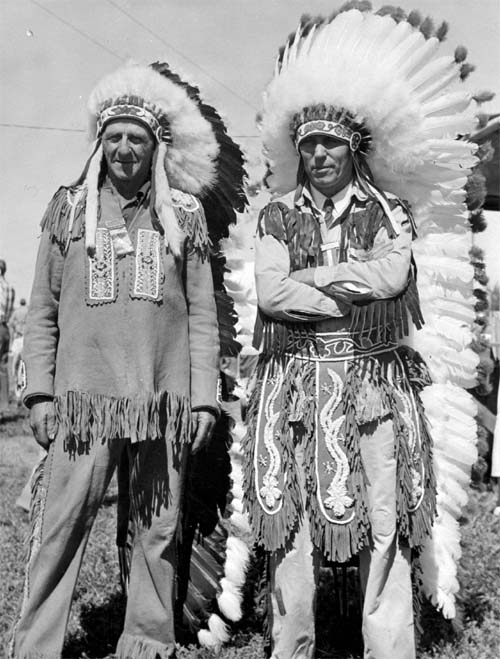
Two men, who don’t look particularly Native American, and with very European names, dressed up as Indian Chiefs for the Minnesota Centennial in 1949. From this set.

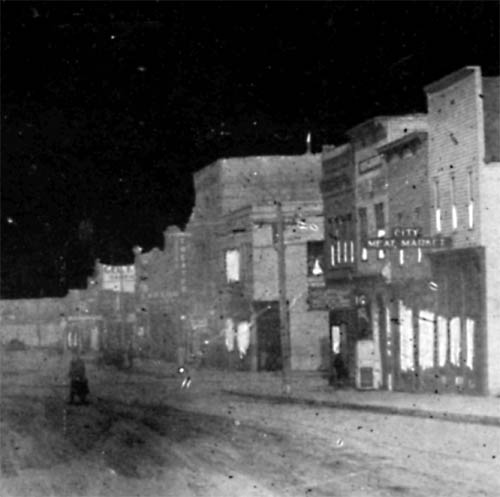
Bemidji, Minnesota: home of Paul Bunyan and Babe the Blue Ox, but the giant pair were still twenty years away when this postcard was mailed in 1916. In the 1910s, it was still a community on the grow, trying to develop roads and railroad access. A new depot was built a few years earlier than when this postcard was mailed and railway passengers were probably one of the main customers of such mementos of midwest travels. Cameras of the time were not particularly efficient at night, so this photo was probably a daytime photo that was underexposed and colored to make it look like ‘night’. In the 1910s, Either Third street has changed significantly, or the view is from a different spot: Google Maps doesn’t help.
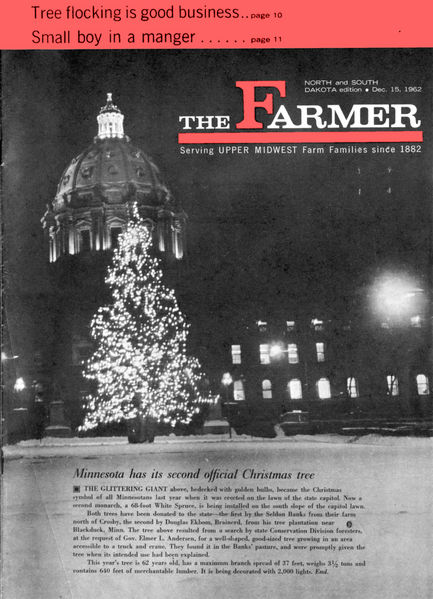
In 1961, new governor Elmer Andersen sent his finest tree-experts to find a grand tree, an amazing tree, a tree that was big and accessible to crane, to place on the State Capital lawn. The tree was found in the pasture of Seldon Banks, who donated it to the state. The image above is of Andersen’s first official Minnesota Christmas Tree, from the year before; the misleading caption referring to the “Second tree” in the article is the 1962 tree that was erected before The Farmer could get a photo for their cover.
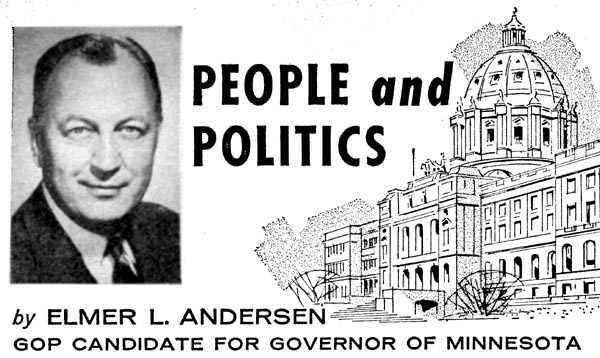
In 1960, Elmer was on the GOP ticket for Governor of the state of Minnesota. A few short weeks after he published this ad in The Farmer magazine, he won his bid, starting a controversy-free term in charge of the state. Two short years later, however, he was undone by 91 voters: in an extremely close election, he lost out to Farm-Labor candidate (and his Lieutenant Governor) Karl Rolvaag. Despite his Republican heart, Andersen was a self-proclaimed liberal to the end, even endorsing John Kerry during the 2004 election. Andersen passed away shortly thereafter.
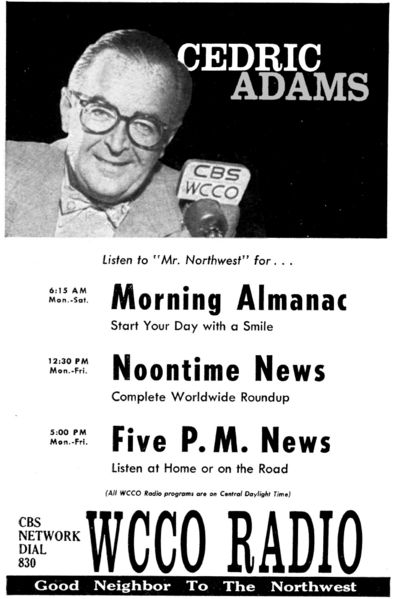
An advertisement from The Farmer, 2 July 1960, for WCCO Broadcaster Cedric Adams.
Welcome to Revere, Minnesota. Walnut Grove, where some of the Laura Ingalls Wilder books were set, is the largest town to the west, and Lamberton is the larger town to the east. All these towns are connected by US Highway 14, but the railroad was once the main way to get from here to there. Only a couple miles separate these towns, with Walnut Grove and Lamberton being larger, and Revere becoming a stopping point between the two.
During the early 1920s, however, the family of one of the residents took a bunch of photos. The photos come from the large lot of negatives I purchased last year. The people are in their twenties and thirties in the negatives I’ve scanned before, and in these photos they seem to be in their teens. I can’t quite tell if they were visiting Revere, or if they had lived in Revere during their youth. Anyhow, the photographer in the family took lots of pictures, capturing quite a bit of Revere’s downtown area.
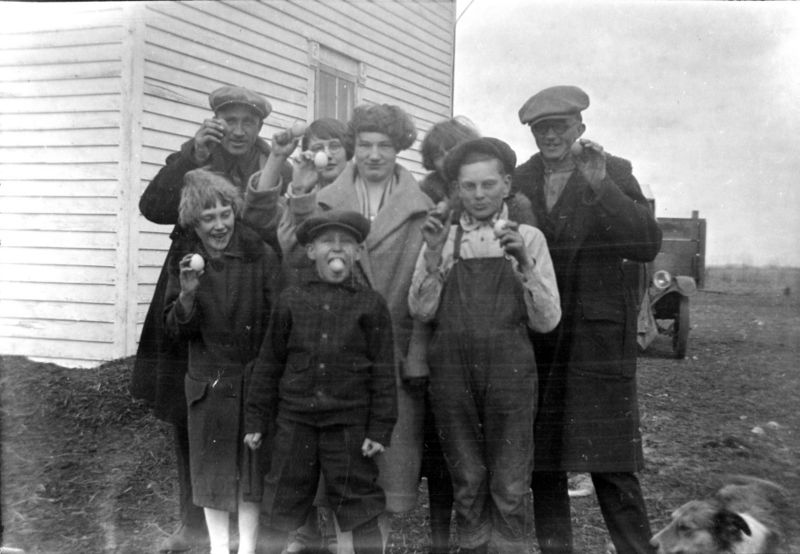
The 1920s send their wishes you a Happy Easter! In this photo, younger versions of the people seen in the Minnesota photo negative set show their Easter morning discoveries. I just hope nobody bumps that kid in the middle too hard.
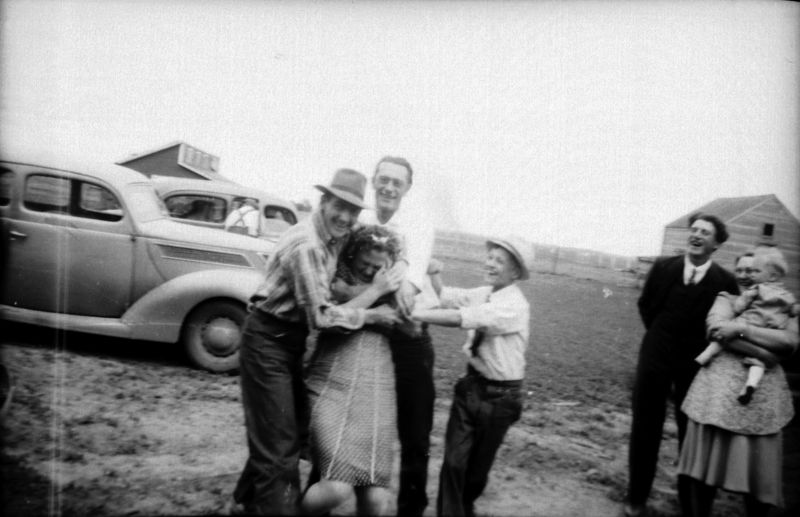 This image was poorly exposed and blurry; I had to squeek out as much as I could using Photoshop — I’ll bet the young lady being tortured in this photo was happy to see that this photo didn’t turn out originally…but she had no idea that 70 years later somebody on a computerized internet would blog about it (I’m not sure she could even parse that last phrase.) I personally love the unposed, candid photos like this one: look at what has been tossed out because it was unfit for photo albums; today is even worse, when you can completely delete an image, permanently, without thinking twice. People who stick to stiffly posed photos are missing out on the vibrant art that can come from an unplanned, quick and dirty photo. The photo above has so much going on in it — the wrestling in the foreground, and what are they stealing from her? The friendly grouping on the far right, who look like they might otherwise not be photographed as in that same grouping because there’s no logical reason to do so. The guy hunched over in the distance, leaning inside an open car door. When people are posed in a stiff, unlively manner, something is lost — I’ll bet Bertha was a far more fun person than this photo would lead the casual viewer to believe.
This image was poorly exposed and blurry; I had to squeek out as much as I could using Photoshop — I’ll bet the young lady being tortured in this photo was happy to see that this photo didn’t turn out originally…but she had no idea that 70 years later somebody on a computerized internet would blog about it (I’m not sure she could even parse that last phrase.) I personally love the unposed, candid photos like this one: look at what has been tossed out because it was unfit for photo albums; today is even worse, when you can completely delete an image, permanently, without thinking twice. People who stick to stiffly posed photos are missing out on the vibrant art that can come from an unplanned, quick and dirty photo. The photo above has so much going on in it — the wrestling in the foreground, and what are they stealing from her? The friendly grouping on the far right, who look like they might otherwise not be photographed as in that same grouping because there’s no logical reason to do so. The guy hunched over in the distance, leaning inside an open car door. When people are posed in a stiff, unlively manner, something is lost — I’ll bet Bertha was a far more fun person than this photo would lead the casual viewer to believe.
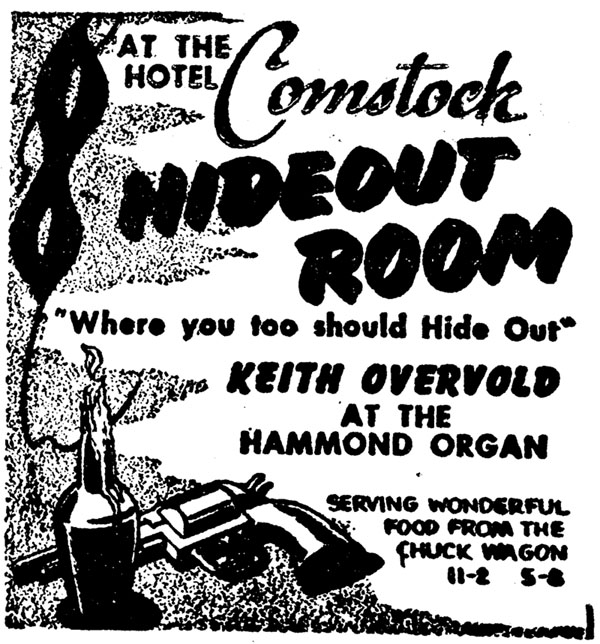
This came from a 1955 Moorhead Daily News, advertising the Comstock Hotel’s Hideout Room. This appears to have been the hotel’s lounge, featuring the dulcet tones of the Hammond organ. The Comstock was located in downtown Moorhead until Urban Renewal flattened and re-drew the flood-ravaged section of downtown to build a mall- wrapped- around- city- hall monolithic building that’s struggled to keep shoppers and tenants. Personally, I prefer how the Comstock looked to the ultramodern styles of the buildings built in its place.